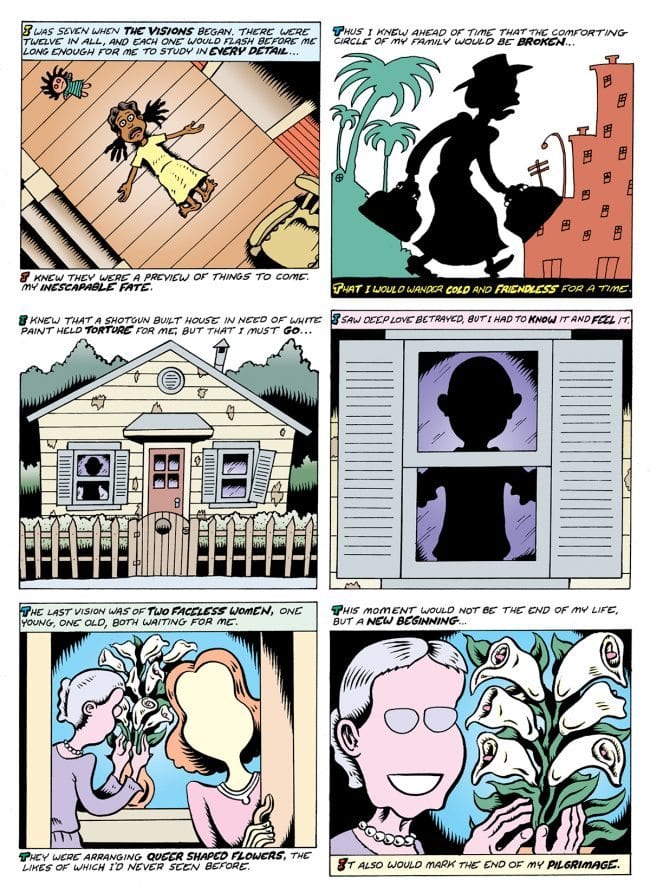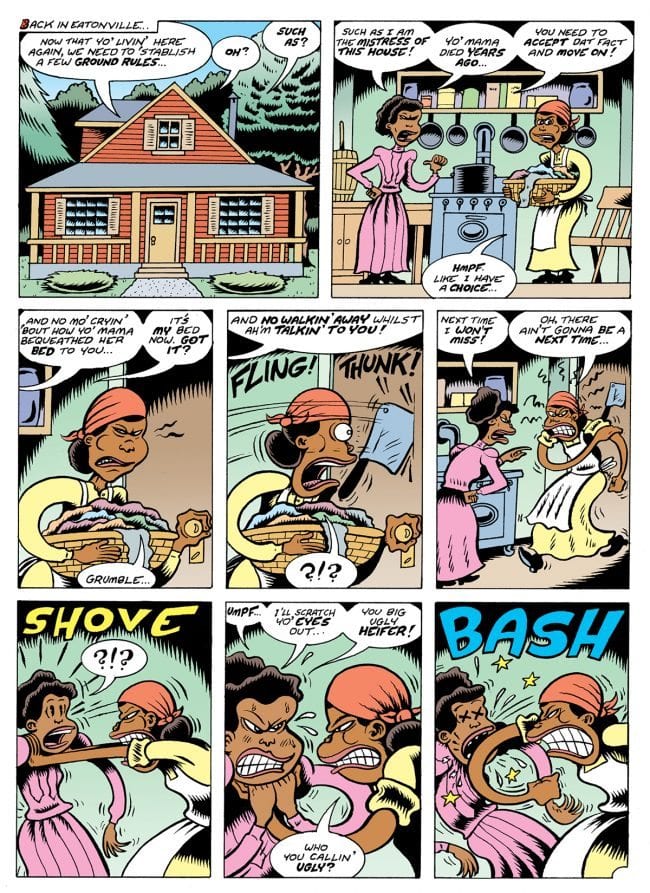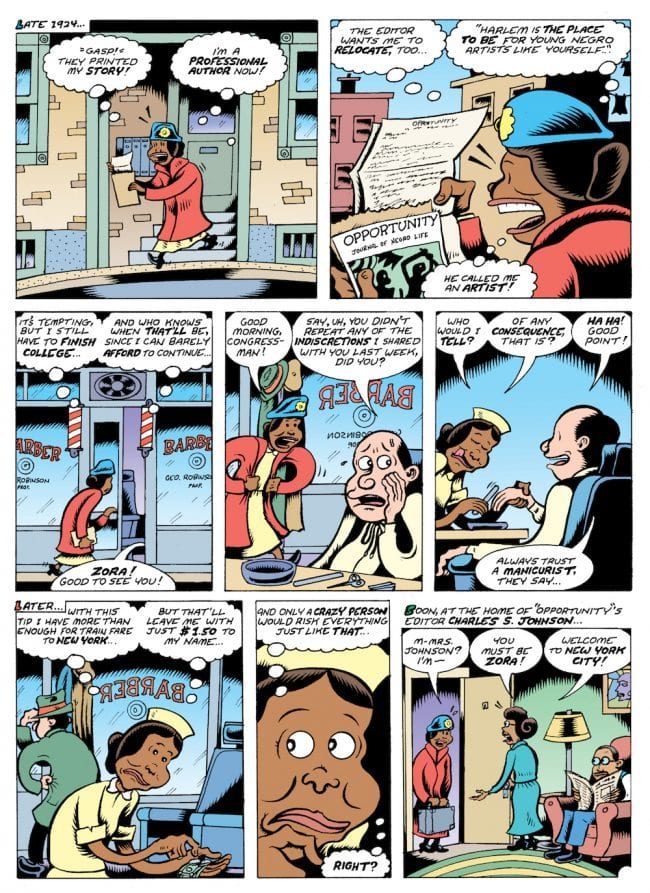Since ending the regular run of his seminal series Hate!, Peter Bagge has been experimenting with all sorts of different genres. He wrote an all-ages series with Yeah! (drawn by Gilbert Hernandez), wrote and drew some of a hilarious comic about a conservative daily strip cartoonist and his "assistants" with Sweatshop, did an amusingly unsettling post-apocalyptic story with Apocalypse Nerd, crafted a Second Life satire called Other Lives (which dated very quickly), and another book that touched on identity and technology, Reset. None of them had a lot of commercial success, but Bagge hit on something with a backup feature in Apocalypse Nerd called Founding Fathers Funnies. It was an accurate yet highly irreverent take on the Founding Fathers of the United States, a subject he clearly found fascinating. He also clearly had a knack for zeroing in on certain details while creating a lively narrative.
That seemed to stem in part from his years of doing reportage and commentary for the libertarian magazine Reason. Despite whatever point of view he had going into a story, he always did a lot of research, was open to listening to the views of others (no matter how kooky), and brought a surprising amount of objectivity and empathy to the table. In other words, he did a far more effective and compelling job than most "real" journalists. Bagge is also far from being in lockstep with all of his party's platforms. His ability to bring both clarity and a strong narrative angle to events made Founding Fathers Funnies effective as a straightforward history and series of mini-biographies, and his no-bullshit sensibilities made it funny. Plus, there's the matter of his art. He never changes it one whit no matter the subject matter at hand.
That means rubbery limbs, exaggerated expressions (including bugged-out eyes), lots of side-eye and tons of flop sweat. Everything is over the top, with Bagge reserving his craziest and most expressive art for the most extreme of situations. His art was the secret weapon of Founding Fathers Funnies, in part because he recast these usually soberly told tales in his own style, which by nature was dramatic and ridiculous. And to be fair, the real details of these stories were indeed dramatic and ridiculous. The style also worked reasonably well for Woman Rebel, his first full-length comics biography published by Drawn & Quarterly. It was interesting that Bagge chose to tell the story of a historically important woman, especially given the dearth of such material in general and comics in particular, but it was her idiosyncratic, iconoclastic and quasi-libertarian tendencies that drew Bagge's attention to the founder of what would become Planned Parenthood.
With Fire!!, Bagge decided to take on another fascinating historical figure: the author, essayist and playwright Zora Neale Hurston. Hurston was a significant cultural figure and a larger-than-life and charismatic character who lit up rooms, but who frequently didn't fit in with her colleagues, among other reasons because she wasn't a leftist. Like Sanger, she was an iconoclast who also had quasi-libertarian beliefs, though not quite in the same way. Now the prospect of a white male author telling Hurston's story drew a bit of controversy when it was announced. Some misunderstood the way publishing works or conflated it with mainstream comics, saying that the book should have been "assigned" to someone else. That argument of course makes no sense because there was no assignment; the book was strictly Bagge's idea.
More problematic in the eyes of others was the match of Bagge's art style with a book about an African-American woman, her family, her friends, etc. Given that African-Americans historically have not depicted with respect in the world of comics, the exaggerated style of Bagge was seen as continuing that legacy. To be sure, given the way that the likes of Will Eisner, Frank King, and many others drew African-American characters and usually denied them a sense of agency and dignity that the Caucasian characters in the strips possessed, this is a point to consider. Others objected to the fact that several of Bagge's characters in Hate! were racist (like Butch Bradley), and even Buddy (theoretically Bagge's stand-in) was known to have used the n-word. Of course, Butch was unequivocally depicted as a monster (especially in his later years) and Buddy was never anything less than an asshole; indeed, the whole purpose of Hate! was a satire of youth culture, albeit one that wasn't trying to be especially sensitive. That said, Bagge has had a number of African-American characters in his other recent books, although always as a part of a wider cast.
In the context of Fire!!, however, none of these criticisms wind up seeming relevant. Yes, there are aspects of Bagge's art that are problematic for telling this kind of story, but he actually addresses some of these issues right up front, before his narrative begins. He is extremely scrupulous when it comes down to sourcing people, images, quotes and events, and the nearly forty pages of notes provide for remarkable reading on their own. When he slightly altered anything, he documented it very carefully. Take the cover, for example. The amusing image of Hurston in a white dress while strapped with a revolver and swearing a Stetson hat while leaning on her car was a composite of several other photos. Every single vignette in this book of carefully paced vignettes is sourced and expanded upon in the notes, which are almost as funny as the story itself. Bagge is not afraid to editorialize from time to time, but he knows when to rein it in and stick to the strict facts and when to weigh in on a subject. That said, it's obvious that he has nothing but admiration and respect for Hurston, and the vast majority of the drawings are simple talking heads or characters just interacting in a normal way. In the end, it will be up to each reader to decide if Bagge's drawings are disrespectful or not based simply on his style, but it does seem clear that mockery is not his intent.
Throughout the book, Bagge treats every character with respect. Foolish behavior is depicted foolishly, but there is absolutely no distinction between the way he draws white characters and the way he draws African-Americans. Bagge is above all else trying to tell a story and trying to do so in an entertaining way while at the same time stay as close to the record as possible. His research for the comic was staggering and I don't blame him for preparing such a carefully prepared endnotes section, because it really does form a kind of secondary narrative of its own. That's especially true when it comes to detailing the backstories of the many famous people she encountered in her life, like Langston Hughes, Ethel Waters, anthropology professor Franz Boaz, and Howard president and noted philosopher Alain Locke, who tended to ignore female students but admired Hurston's abilities as a writer.
Bagge focuses on several key ideas in the book. First and foremost was Hurston's life growing up in Eatonville, Florida in the 1890s. Eatonville was the first all-black city in America. That had a profound effect on Hurston as being surrounded by people who looked like her meant that she never felt inferior. Certainly, she had issues with her family (especially her father after he quickly remarried after her mother died), but the structure and culture of the town itself were indispensable in how she came to view the world and also had a significant (and frequently controversial) impact on how she came to view forced integration.
Secondly, Bagge focused on Hurston's life as an academic, in the field of cultural anthropology. She spent years crisscrossing the American south, seeking out the local folklore and tale-tellers. A lot of the book details some of the more colorful encounters she had in her travels. The sequences in which she learns Hoodoo are especially fascinating and outrageous. Thirdly comes Hurston as author and firebrand, fighting against what she saw as respectability politics centered around class. Finally, Bagge examines the ways in which she was regarded as a novelty even by white people she was friendly with, but also how she eventually felt betrayed by her fellow black people.

As noted earlier, Bagge took a profound interest in Hurston's politics and identity. She wrote her books in local dialect, which displeased some of her mentors, but as far as she was concerned, she simply wrote what she had heard growing up. She disdained Communism and regretted its influence on her friends, even as she became an outcast as a result. While she despised the viciousness of Jim Crow laws, she saw forced integration as a mistake because she thought that it would only result in black children getting the short end of the stick in now-integrated schools. She instead wanted more money going to schools in mostly black areas. Of course, she rarely had to deal with the consequences of Jim Crow laws herself, and her charm and ability often got her out of sticky situations. Dealing with Jim Crow racism on a daily basis may well have changed her mind, even if her arguments against integration did in some regards make sense. Black children did get the short end of the stick. They were looked at as potential janitors, not potential doctors. Integration didn't make racism go away. What it did do was wipe out one aspect of its institutionalization, and while that victory was largely conceptual at first, history has shown that it was absolutely necessary, even with its fallout.
What ties all of these themes and ideas together is Bagge's skill at constructing short vignettes from Hurston's life that touch on her charm, talent, and occasional volatility. Bagge has had years of experience mastering how to properly pace a funny story that's mostly comprised of people sitting around talking to each other, and it truly pays off in biographical stories like this. In terms of the story's rhythms, it feels at times like an issue of Hate! starring Hurston and her friends. Despite the cartoony quality of Bagge's drawings, he's always been incredibly skilled at depicting body language and the ways in which bodies interact with each other in space. His panels are always immaculately composed and his page design is always bright & attractive while remaining clear and easy for the eye to navigate. In bringing Zora Neale Hurston to life in such a bright and vivid manner without ducking difficult issues, Bagge proves to be the right person for the job.









